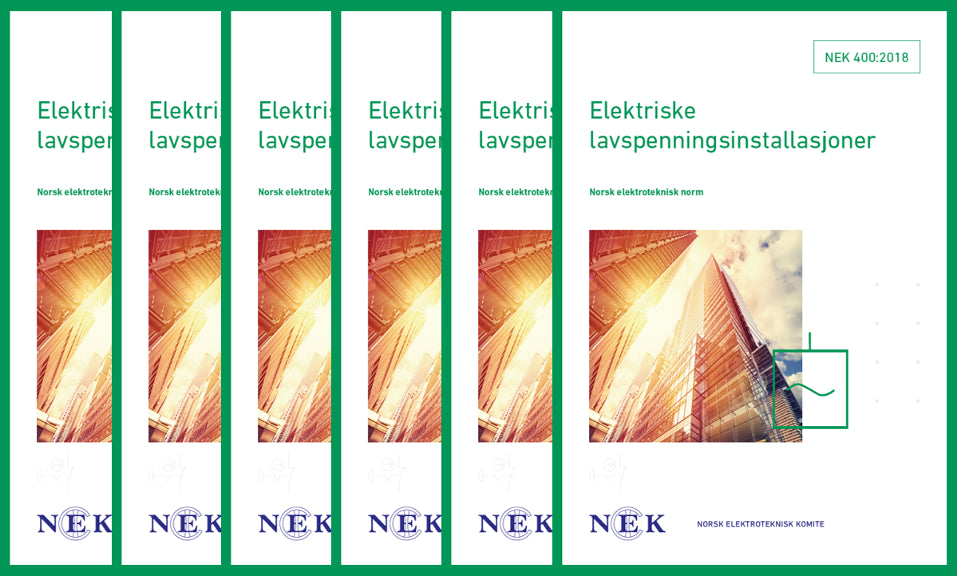Charging guide: NEK 400 - requirementes and standards with charging electrical vehicles and plug-in hybrids
NEK 400 - Low voltage electrical installations
The Norwegian Electrotechnical Committee (NEK) is often abbreviated NEK 400 and deals with the planning and execution of electrical low-voltage installations. The collection of standards sets out requirements to achieve satisfactory electrical safety, as well as guidelines for the design of electrical low-voltage installations. NEK 400 is intended for daily use in all installation businesses and consulting engineering businesses that operate within the scope of the collection of standards. NEK 400 is published every four years and the first time was in 1998 and publishes revised editions every four years. The latest edition was in 2022.

Changes in NEK 400:2022
New NEK 400:2022 now removes the possibility of charging electric vehicles via a regular socket as a permanent solution. In the past, there has been a requirement for a separate circuit of a maximum of 10A and an earth fault circuit breaker type B in an ordinary socket (schuko contact). The option to charge via an industrial socket (CEE) has also been removed as a permanent solution in NEK 400:2022. The changes in NEK 400:2022 will only apply to new installations and do not have a retroactive effect. If you make changes to an existing charging point, a charging station must be installed. It still means that you can still emergency charge legally via schuko / CEE as long as it is not your permanent solution over time.
Adjustments in NEK 400:2018
Since NEK 400:2014, adjustments and changes have been made to the international standards (IEC). The previous NEK 400 determined, for example, that all charging points must have their own supply rate as one of several requirements to make electric car charging safer. However, this requirement has created a number of challenges for those who are going to establish a simple charging point in a detached garage. We have therefore summarized the most important changes related to charging electric cars.
Main points and changes for NEK 400:2018
1. Generally available charging sockets (public) must be Type 2 socket/socket
2. Industrial socket and household socket have been removed as a solution for generally accessible charging points
3. It is now required that the connection point must be protected by a surge protector. This could be the surge protector that stands in front of the entire installation.
4. The requirement for a dedicated course has been continued, but if a new charging point is to be installed in an existing detached garage, this can be mounted on the existing course, with some reservations* (NEK 400:722.305.301 - Division of installations)
5. Charging on a normal socket (Schuko) is legal for private use, but must be protected with an overcurrent protection device of 10A and earth-fault circuit breaker Type B, as well as dedicated course
6. Extension cords must not be used
7. Transitions of various types cannot be used, except if it complies with the recommendations of the manufacturer of the equipment and the electric vehicle
* 722.305.301: If one new connection point for an electric vehicle is to be installed for use in an existing, detached private garage, carport or outbuilding or similar, this connection point may, on the condition that the disadvantage of inadvertent disconnection of the course is accepted by owner, is installed on an existing consumer course. Note that the current course must not supply other connection points and must only supply equipment and sockets installed in the immediate vicinity of the connection point to be installed.
This means that you can connect the charging point on the same course as lights and sockets that are installed in the immediate vicinity of the garage. This results in much easier installation of charging points for many.
It is essential that the solution has the right earth fault protection where there is an earth fault protection Type A in the fuse box and a Type B. This can be solved in two ways:
1. Mount earth fault protection Type B in the distribution (fuse box/enclosure) which protects the entire course
2. The course is protected by an earth fault protection Type A and the charging station has built-in DC monitoring (RDC-DD/DC-RCM 6mA) in accordance with NEK IEC 62955.
Feel free to read more in our charging guide or contact us for assistance.
 FedEx delivery in the EU
FedEx delivery in the EU
